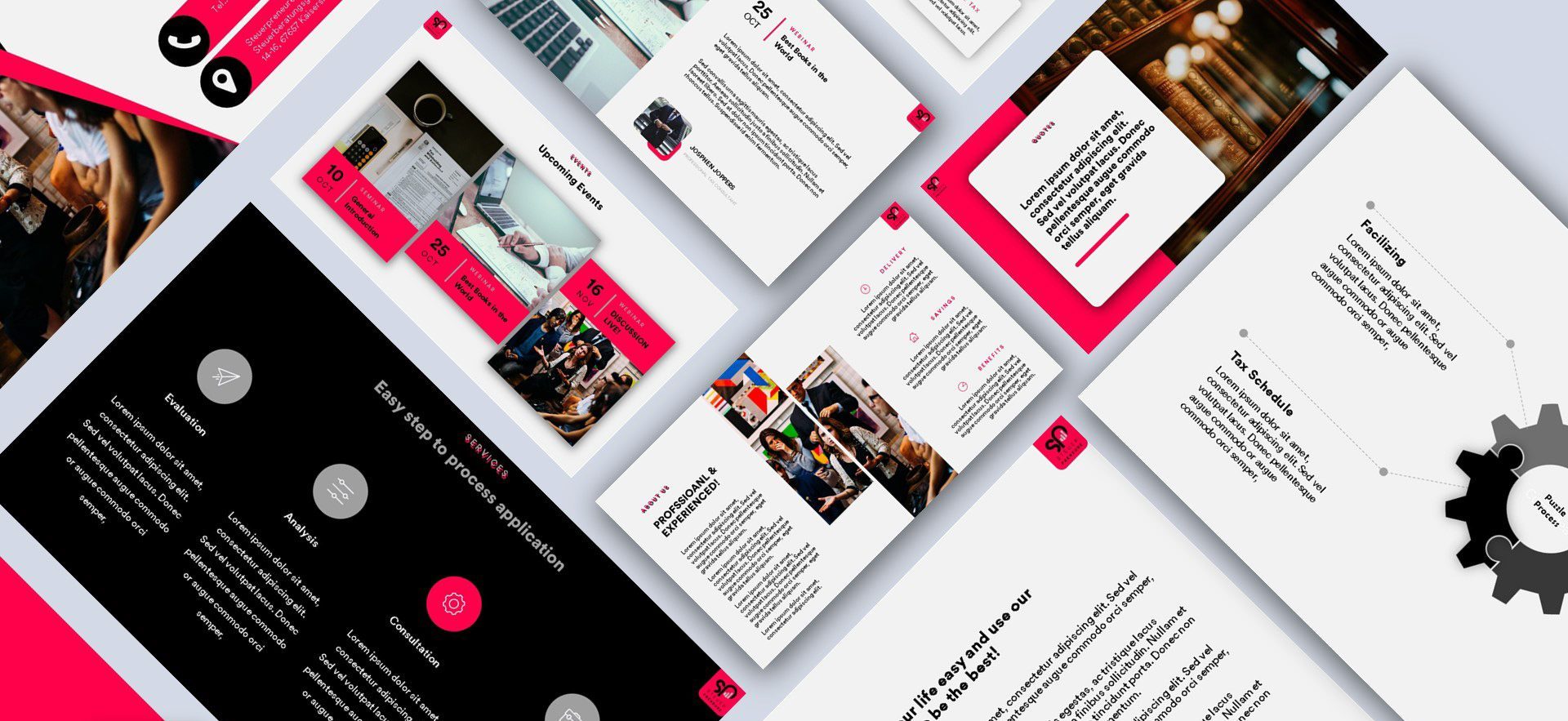What is a Pitch Deck?
A pitch deck is a concise presentation used to showcase a business idea to potential investors, partners, or stakeholders. Typically consisting of a series of slides, it aims to convey key information about your company, its vision, market opportunity, and financial projections. The primary goal is to capture interest and secure further discussions or funding. A well-crafted pitch deck can make the difference between a successful funding round and a missed opportunity.

Key Elements of a Winning Pitch Deck
A successful pitch deck effectively communicates your business’s potential and engages your audience. Essential elements include:
- Introduction: Start with a compelling overview of your business, highlighting its unique aspects.
- Problem Statement: Clearly articulate the problem your business addresses.
- Solution: Present your product or service as the solution to the problem.
- Market Opportunity: Showcase the size and potential of your target market.
- Business Model: Explain how your company plans to make money.
- Traction: Provide evidence of progress, such as user growth or revenue.
- Financials: Outline key financial metrics and projections in the deck including the section of your pitch.
- Team: Highlight the expertise and experience of your team members.
- Call-to-Action: Clearly state what you’re asking from investors or partners.
7 Proven Strategies to Design a Pitch Deck Stand Out
1. Focus on Visual Design
Visual design plays a critical role in the effectiveness of your pitch deck. A well-designed deck not only grabs attention but also ensures that your message is communicated clearly and professionally.
Importance of Consistent Branding
Consistency in branding helps reinforce your company’s identity and makes your pitch deck more memorable. Use your company’s color scheme, fonts, and logo throughout the presentation to create a cohesive look. This consistency helps establish trust and credibility with your audience, which is crucial for attracting venture capital.
- Create a Professional Template: Design a custom template that aligns with your brand guidelines. This ensures uniformity and strengthens brand recognition.
- Maintain Visual Harmony: Use a consistent style for headings, bullet points, and imagery. Avoid mixing different design elements that can make the deck look cluttered or disjointed.
Use of High-Quality Images and Graphics
High-quality images and graphics can make your pitch deck visually appealing and help convey complex information more effectively. Avoid low-resolution or generic stock images, as they can detract from the professionalism of your presentation.
- Select Relevant Visuals: Choose images and graphics that support your key messages and enhance understanding. For instance, use charts to illustrate financial data or infographics to explain your business model.
- Ensure Visual Clarity: Make sure all visuals are clear and easy to interpret. Avoid overcrowding slides with too many images or graphics, which can overwhelm your audience.
2. Highlight Your Unique Selling Proposition
Your unique selling proposition (USP) is what sets your business apart from the competition. Clearly highlighting your USP in your pitch deck is crucial to demonstrating the distinct value your business offers.
Differentiating from Competitors
To effectively highlight your USP, you need to clearly differentiate your product or service from those of your competitors. Focus on what makes your offering unique and why it is superior to alternatives in the market.
- Identify Key Differentiators: Pinpoint the specific features, benefits, or innovations that set your product or service apart to impress venture capitalists. This could be a proprietary technology, a novel approach, or unique market positioning.
- Showcase Competitive Advantages: Use comparisons, case studies, or testimonials to illustrate how your USP provides better solutions or greater value than competitor offerings.
Communicating Unique Benefits Clearly
Once you’ve identified your USP, it’s important to communicate these benefits clearly and compellingly in your pitch deck. This helps potential investors or partners quickly understand the value your business brings to the table.
- Use Clear, Direct Language: Avoid jargon and technical terms that may confuse your audience. Instead, use straightforward language to describe the benefits and value your USP provides.
- Highlight Real-World Impact: Provide examples or evidence of how your USP translates into tangible benefits for customers or users. This could include success stories, metrics, or customer feedback.
3. Data-Driven Insights
Incorporating data-driven insights into your pitch deck is essential for demonstrating the credibility and potential of your business to prospective investors. Well-presented metrics and analytics not only bolster your arguments but also build confidence with investors by showcasing your business’s performance and future prospects.
Incorporating Relevant Metrics and Analytics
To make a compelling case, include metrics and analytics that are directly relevant to your business goals and market opportunity. This data helps to substantiate your claims and provides a quantitative basis for your projections and strategy.
- Choose Key Metrics: Focus on metrics that are most pertinent to your business, such as market size, growth rates, customer acquisition costs, and revenue projections in your PowerPoint presentation. Avoid overwhelming your audience with excessive data; instead, select the most impactful figures.
- Provide Context: Explain the significance of the metrics you present. Show how these figures support your business model and validate your growth strategy.
Visualizing Data for Impact
Effective visualization of data enhances comprehension and retention. Well-designed charts, graphs, and infographics can make complex information more accessible and engaging.
- Select Appropriate Visuals: Use charts and graphs that best represent the data you’re presenting. For example, use bar graphs for comparing values, pie charts for showing proportions, and line charts for trends over time.
- Ensure Clarity: Make sure all visuals are easy to read and interpret. Use contrasting colors and clear labels to highlight key points and avoid cluttered or confusing graphics.
4. Keep it Concise and to the Point
A pitch deck should convey essential information efficiently and effectively. Keeping your content concise helps maintain your audience’s attention and ensures that your key messages are communicated clearly.
Limiting Slide Content
Overloading slides with text or information can detract from the impact of your pitch. Aim for simplicity and clarity in each slide to make your points more memorable.
- Use Bullet Points: Break down complex information into bullet points to make it easier to digest. Keep bullet points brief and focused on key ideas.
- Avoid Long Paragraphs: Limit the amount of text on each slide. Instead of lengthy explanations, use succinct phrases and visuals in your PDF to convey your message effectively.
Focusing on Key Messages
Highlight the most important aspects of your business and pitch to ensure that your PowerPoint resonates with your audience. By focusing on key messages, you ensure that your audience retains the critical information you want to communicate.
- Prioritize Information: Identify and emphasize the most crucial elements of your pitch, such as your value proposition, market opportunity, and financial highlights. Ensure these are clearly presented and repeated throughout the deck.
- Be Clear and Direct: Be clear and direct in your communication to make all the difference in your pitch. Avoid ambiguous statements and focus on delivering clear, direct messages. Make sure each slide reinforces your overall narrative and supports your business’s main objectives.
5. Tell a Compelling Story
Crafting a compelling narrative is essential for making your pitch deck memorable and impactful. A well-told story captures attention, engages emotions, and makes your business idea more relatable and convincing.
Starting with a Hook
Your pitch deck should start with a strong hook to immediately capture the audience’s interest and engage potential angel investors. A compelling opening sets the tone and draws viewers into your narrative.
- Present a Provocative Problem: Begin by highlighting a pressing issue or challenge that your business addresses. This approach grabs attention by framing your solution as a response to a significant problem.
- Share an Engaging Anecdote: Use a relevant story or personal anecdote that illustrates the problem and hints at your solution. This helps create an emotional connection and makes your pitch more memorable.
Engaging the Audience Emotionally
Emotional engagement can significantly enhance the impact of your pitch. Connecting with your audience on an emotional level helps make your business idea resonate more deeply.
- Highlight Real-Life Impact: Use stories or testimonials to show how your product or service has positively affected real customers or solved their problems. This humanizes your pitch and builds empathy.
- Use Persuasive Language: Craft your narrative using language that appeals to emotions. Focus on the potential positive outcomes and benefits of your solution to evoke excitement and optimism.
6. Showcase Your Team’s Expertise
Investors want to know that the team behind the pitch is capable and experienced. Demonstrating your team’s expertise and qualifications can instill confidence and make your pitch more convincing.
Highlighting Key Team Members
Feature the most crucial members of your team to showcase their skills and experiences. This helps establish credibility and reassures investors about the team’s ability to execute the business plan.
- Profile Key Roles: Provide brief profiles of team members, focusing on their roles, achievements, and expertise. Highlight any relevant experience or accomplishments that are directly related to your business.
- Showcase Complementary Skills: Emphasize how the diverse skills and experiences of your team members complement each other and contribute to the overall success of the business.
Demonstrating Industry Experience
Illustrating your team’s experience in the industry can further bolster your pitch by showing that your team understands the market and has a track record of success.
- Highlight Relevant Backgrounds: Mention any previous industry experience, successful projects, or notable achievements. This helps demonstrate that your team has the knowledge and background needed to navigate the industry.
- Showcase Thought Leadership: If applicable, highlight any industry recognition, publications, or speaking engagements that position your team as thought leaders in the field.
7. Include a Strong Call-to-Action
A strong call-to-action (CTA) is crucial for guiding your audience toward the next steps in securing venture capital. A clear and direct CTA ensures that your pitch deck ends with a definitive and actionable request.
Defining Next Steps
Clearly outline what you want from your audience and the actions they should take following your pitch. This helps set expectations and provides a clear path for further engagement.
- Specify What You’re Asking For: Whether you’re seeking investment, partnerships, or feedback, make your request explicit and detailed. Outline the specific terms or conditions of the ask if applicable.
- Provide Contact Information: Include clear instructions on how to follow up or contact you for further discussion with a prospective investor. Make it easy for interested parties to reach out and take the next step.
Making the Ask Clear and Direct
Your CTA should be straightforward and compelling. A well-articulated ask helps ensure that your audience understands exactly what you’re looking for and feels motivated to act.
- Use Direct Language: Avoid vague or ambiguous statements. Clearly articulate your request in a way that is easy to understand and act upon.
- Emphasize Urgency or Benefits: Highlight any time-sensitive opportunities or benefits associated with taking action. This can create a sense of urgency and encourage prompt responses.
Mistakes to Avoid When Creating a Pitch Deck
Creating an effective pitch deck involves more than just including the right content; it requires careful attention to how that content is presented. Avoiding common pitfalls can significantly enhance the impact of your pitch and increase your chances of success. Here are key mistakes to watch out for and how to steer clear of them.
Overloading Slides with Information
One of the most frequent mistakes in pitch deck creation is overloading slides with too much information. When slides are crowded with text and data, they become difficult to read and can overwhelm your audience.
Importance of Simplicity and Focus
Simplicity and focus are crucial for maintaining clarity and keeping your audience engaged. A well-designed pitch deck should convey key messages efficiently and effectively.
- Prioritize Key Points: Each slide should focus on a single idea or message to effectively make a pitch. Avoid cramming multiple points into one slide; instead, spread out information across several slides to keep it clear and digestible.
- Use Visuals Wisely: Incorporate visuals like charts, graphs, and images to illustrate points and make the content more engaging. Ensure these visuals are relevant and enhance understanding rather than add clutter.
Neglecting the Audience’s Perspective
A pitch deck should be tailored to the interests and needs of your audience. Neglecting this can result in a presentation that misses the mark and fails to resonate with potential investors or partners.
Importance of Understanding Your Audience
Understanding your audience is key to delivering a pitch that addresses their specific concerns and interests. Tailoring your message to their needs can significantly increase the effectiveness of your pitch.
- Research Your Audience: Know who you are presenting to, including their background, interests, and what they value in a pitch. This helps in customizing your content to align with their expectations.
- Address Pain Points: Focus on how your business addresses the specific problems or needs of your audience. Highlighting these aspects shows that you have a clear understanding of their concerns and how your solution provides value.
Failing to Rehearse
Failing to rehearse your pitch can lead to a presentation that is disorganized, lacks confidence, and fails to make a strong impact. Practice is essential to delivering a smooth and compelling pitch.

Significance of Practicing the Pitch
Rehearsing helps refine your delivery, improve timing, and ensure that you present your key points effectively. A well-rehearsed pitch demonstrates preparedness and confidence.
- Practice Multiple Times: Rehearse your pitch several times to become comfortable with the flow of your presentation. This helps identify any awkward transitions or areas that need improvement.
- Seek Feedback: Practice in front of others and ask for constructive feedback. This can provide insights into how your pitch is perceived and highlight areas that may need adjustment.









Pingback: Top 10 Best Pitch Deck Design Agencies in 2025
Pingback: How Do You Structure a Pitch Deck That Impresses Any Investor in 2026?